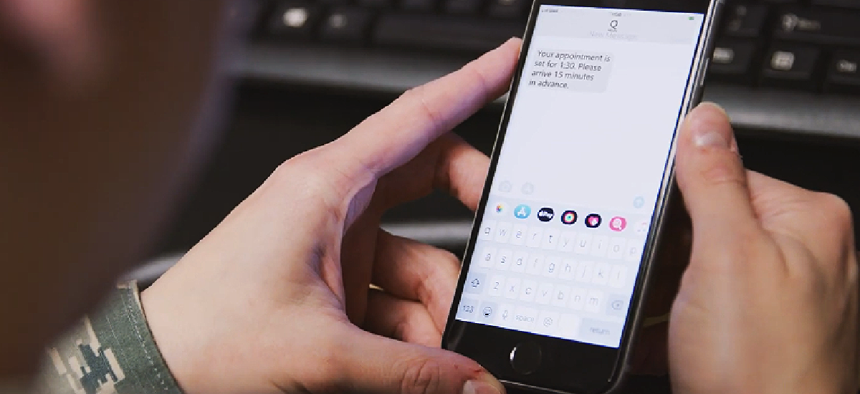
Grass-roots innovation builds virtual queue
With support and funding from squadron innovation funds, the 57th Munitions Squadron at Nellis Air Force Base sourced the Qless solution and adapted it so staff on base, their dependents, retirees and contractors can remotely get in line to make adjustments to their insurance coverage.
A new automated queuing system at the Air Force keeps service members from wasting time waiting in line.
Previously when airmen and -women wanted to make changes to their insurance coverage, they had to go to the Military Personnel Flight office, take a paper ticket and wait until their number was called. Because they had no way to know when it was their turn, they couldn't leave the building, according to Air Force spokesperson Maj. Bryan Lewis.
When Tech Sgt. Henry Herzog of the 57th Munitions Squadron at Nellis Air Force Base in Nevada was waiting for an update about his new son, he thought about how his local Department of Motor Vehicles used Qless' cloud-based solution to let people get into a virtual line, freeing them from waiting at the DMV office.
He took his idea to the Nellis AFWERX Spark Cell, a grass-roots innovation program that leverages base-level entrepreneurs to solve tactical-level pain points. Spark is a base-level component of the larger AFWERX program, established in 2017 to spur collaboration among service members, industry, entrepreneurs and researchers. It has become "fusion of capabilities," connecting innovators and accelerating results for Air Force culture and technology, Lewis said in an email.
With support and funding from squadron innovation funds, the munitions squad sourced the Qless solution and adapted it so the base's staff, their dependents, retirees and contractors can remotely get in line from anywhere. For instance, they can join the queue from their office computer, enabling them to continue working until they receive a notification that they are next, Lewis said. They can also download the Qless app to their smartphone or mobile device to join and monitor the line, or they can get in line via a text message.
“From an Airman’s perspective, they can easily log in from a government [Non-classified IP Router Network] computer, any commercial internet computer or their cell phone and join a queue remotely,” Lewis said. “They can also arrive at the building and get added to the queue. Because of the ability to remote-page via cell phone, they can then leave the building and do other things with the time between entering the queue and receiving service.”
It took about four months to go from idea to reality. The subscription service costs about $24,000 a year and is available via the General Services Administration, Lewis said. The solution the munitions squad devised is also scalable to any Air Force base, Capt. Douglas Mayo, chief of innovation at Spark-Nellis, said in an AFWERX video.
According AFWERX, the technology is saving about $130,000 at Nellis alone. Lewis qualified that figure: “This is very rough math, and we were conservative with these numbers. The number is strictly based on manhours saved. The assumptions were that if an individual had a longer than one-hour wait time, they would recoup 0.5 hours of work. This was based on our first two months of use and extrapolated out. That figure does not include subtracting the costs. After costs, it would be approximately $100,000 per year savings.”
Some of the biggest benefits that the technology brings are tougher to quantify, with the most important being improved quality of life, Lewis added. “Rather than being confined to a waiting room, airmen can be freed up to complete higher value work, or it may give them the opportunity to grab lunch or accomplish other ‘to-do list’ items,” he said.
AFWERX is building a decentralized network Spark Cells at Air Force bases worldwide to execute locally generated ideas and projects. The cells give airmen and -women access to resources and support across the Air Force innovation network, which enables rapid communication and scaling across the enterprise, Lewis said.
“The Spark Cell is important because it allows base-level airmen to bring up their pain points and have a mechanism by which they can solve those pain points,” Mayo said in the video.
For other bases interested in starting a Spark Cell, Mayo offered four tips:
- Find people who are passionate about solving problems.
- Give them the tools they need, such as a Form 9 for procurement, a contracting officer, funds and squadron support.
- Let them run.
- Don’t be afraid to fail.
This article first appeared on GCN, a partner site of Defense Systems.
NEXT STORY: NSA: Just say no to hacking back

